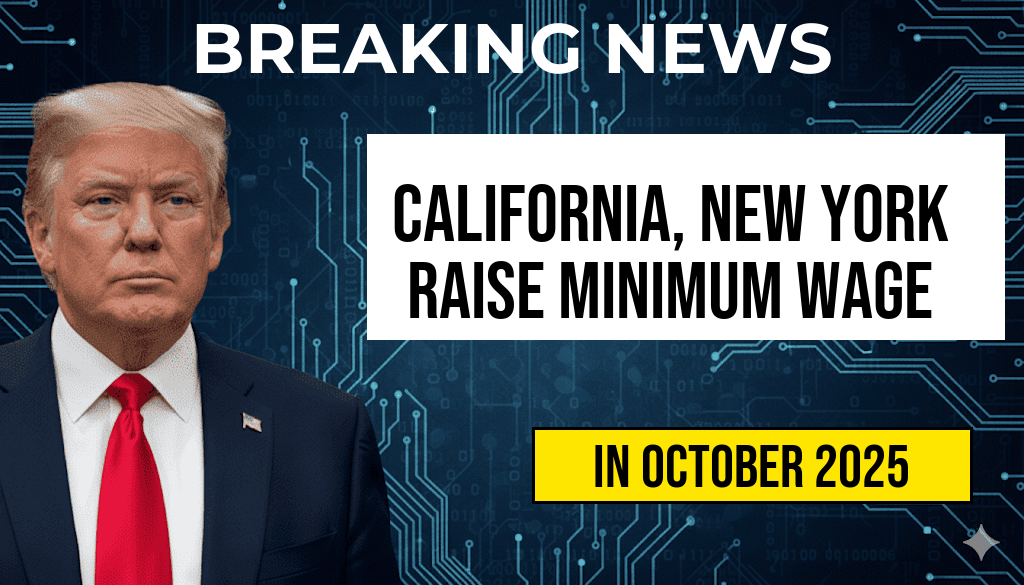California and New York have announced plans to raise their minimum wages to $16.50 per hour over the coming months, a move expected to significantly influence local economies and labor markets. The increased wage floor aims to boost earnings for millions of workers, many of whom have faced stagnant wages amid rising living costs. However, economists and business leaders are closely examining potential repercussions, including shifts in employment levels, inflationary pressures, and changes in consumer spending. As these states implement the new minimum wage, stakeholders across sectors are preparing for a period of adjustment that could reshape wage standards nationwide.
Details of the Wage Increase and Implementation Timeline
California’s Path to $16.50
- The Golden State plans to reach a $16.50/hour minimum wage by July 2024, gradually increasing from the current $15.50.
- The phased approach applies to large employers (more than 26 employees), with smaller businesses expected to follow suit by 2026.
- Governor Gavin Newsom emphasized the importance of supporting low-income workers while balancing economic stability.
New York’s Schedule for Raising Wages
- New York’s minimum wage will also hit $16.50/hour by the end of 2024, with regional adjustments based on cost of living.
- In New York City, the wage increase is set to be implemented in phases, starting with a raise to $15.75 in late 2023, followed by incremental hikes.
- Upstate regions will see similar phased increases, reflecting differing economic conditions across the state.
Impact on Local Economies and Business Operations
Potential Boost in Consumer Spending
With higher wages, workers are expected to have increased purchasing power, which could stimulate local retail, hospitality, and service sectors. This boost might lead to higher sales volumes and potentially create new jobs to meet increased demand. According to economic models, an uptick in disposable income often correlates with increased consumer activity, benefiting small businesses and regional economies.
Employment and Business Cost Considerations
Conversely, some business owners express concern over rising labor costs. Small and medium enterprises, in particular, may face tighter profit margins, prompting considerations such as automation, reduced hours, or even layoffs. A study from the Wikipedia entry on minimum wage highlights that while some sectors experience employment gains, others could see employment reductions or slowed hiring growth.
Sector-Specific Effects
| Industry | Potential Impact | Notes |
|---|---|---|
| Retail | Increased wages for entry-level positions | Possible rise in prices to offset higher labor costs |
| Hospitality & Food Service | Improved employee retention and satisfaction | Staffing adjustments may occur if costs rise significantly |
| Manufacturing | Potential pressure to automate or relocate | Higher wages may accelerate automation trends |
Broader Economic and Policy Context
State-Level Wage Policies and National Trends
California and New York’s wage hikes are part of a broader movement toward higher minimum wages nationwide. Several states and cities are adopting or debating similar increases, often citing economic inequality and worker protection as driving factors. The federal minimum wage remains at $7.25, but advocates argue that regional adjustments better reflect local costs of living. For more on the history and debates surrounding minimum wage policies, visit Wikipedia’s coverage of U.S. minimum wage laws.
Economic Experts’ Perspectives
Analysts warn that while raising the minimum wage can reduce poverty and improve quality of life, it may also lead to unintended consequences such as inflationary pressures or reduced employment opportunities in vulnerable sectors. A report by Forbes highlights that the impact largely depends on how businesses adapt and how consumer demand responds to increased wages.
Monitoring and Future Developments
Both states have committed to closely monitoring the effects of the wage increases through economic studies and stakeholder feedback. Policymakers are particularly attentive to small business resilience and employment trends. As the implementation progresses, updates from state agencies and economic research centers will shed light on the real-world outcomes of these minimum wage adjustments.
As California and New York move toward their $16.50 hourly wage goal, the nation watches how these bold policy shifts influence labor standards, economic growth, and the ongoing debate over living wages. The evolving landscape underscores the complexity of balancing worker protections with economic vitality in diverse regional contexts.
Frequently Asked Questions
What is the new minimum wage proposed for California and New York?
The proposed minimum wage for California and New York is set to reach $16.50 per hour, aiming to improve income levels for workers in both states.
How will the increased minimum wage affect local economies?
The increase to $16.50 per hour is expected to boost consumer spending, support local businesses, and potentially encourage job growth, thereby positively impacting the local economies.
When will the new minimum wage take effect in California and New York?
The specific implementation dates may vary by region, but the plans are set to phase in the $16.50 hourly wage over the coming months or years, depending on local legislation.
Which workers will be most affected by the minimum wage increase?
The low- and middle-income workers across various sectors, including retail, hospitality, and service industries, are expected to benefit the most from the higher wage standards.
Are there any concerns or criticisms related to the wage increase?
Some critics argue that the higher wages could lead to increased business costs and potential job cuts or price hikes, but proponents believe it will promote economic growth and worker well-being.










